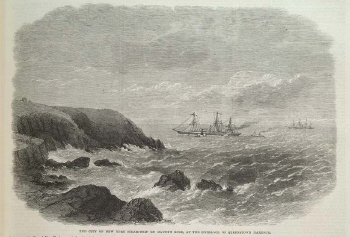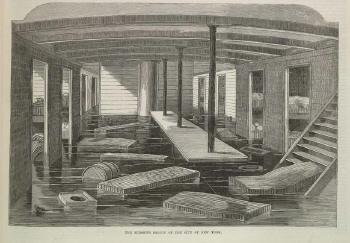

Tod & Macgregor Shiplist
|
Yard No.: |
107 |
|
Name: |
|
|
Year: |
1860 |
|
Description: |
Passenger Ship |
|
Webpage: |
|
|
Picture: |
|
|
Tonnage: |
2,176 |
|
Length: |
294.8 |
|
Width: |
39.6 |
|
H.P.: |
350 later 550 horizontal two-cylinder trunk engine |
|
Type: |
Iron, single screw, three masts, one funnel ¹ |
|
Customer: |
Inman |
|
Fate: |
29th March 1864, she struck the sunken reef known as Daunt's Rock, near Queenstown, no lives lost. |
|
Points of Note: |
|
|
Date of Launch: |
12th April 1861 |
Notes:
¹ [Trans-Atlantic Passenger Ships, Eugene W.Smith]
Much of the success of the Inman Line was due to the economy of their ships, for just as they had been the first to throw themselves whole-heartedly into the principle of employing of employing iron screw ships, so they believed in keeping themselves abreast of every machinery development which made for economy. After being dropped for some years, the surface condenser attracted the attention of engineers again about 1860 and the Inman Company fitted it in their first City of New York, which was built in 1861 contemporarily with the Allan ships similarly fitted.
She had horizontal two-cylinder trunk engines, the dimensions being 69 inches by 36, which worked up to about 1,500 i.h.p., and were regarded as being conspicuously economical at the time.
On the 29th March 1864, she struck the sunken reef known as Daunt's Rock, near Queenstown, she sank with no loss of life.


An interesting story occurred in 1911.
The popular Cunarder Ivernia had the bad luck to strand on Daunt's Rock at the entrance to Queenstown Harbour, but she came off in a very short time and entered the port. It was at first thought that she had sustained very little damage, but she was found to be filling rapidly and had to be beached in a hurry. When she was dry-docked portions of an old wreck were found embedded in her hull, and there was an infinite discussion as to whether it was the Inman City of New York, which came to grief in 1864, or the Gurion Chicago, which was wrecked on the same spot in 1868.
[A Century of Atlantic Travel, FG Bowen]